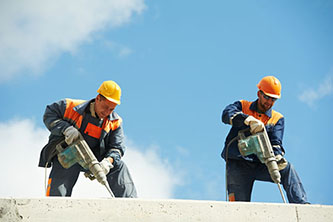An official website of the United States government
 United States Department of Labor
United States Department of Labor

Perform tasks involving physical labor at construction sites. May operate hand and power tools of all types: air hammers, earth tampers, cement mixers, small mechanical hoists, surveying and measuring equipment, and a variety of other equipment and instruments. May clean and prepare sites, dig trenches, set braces to support the sides of excavations, erect scaffolding, and clean up rubble, debris, and other waste materials. May assist other craft workers. Construction laborers who primarily assist a particular craft worker are classified under "Helpers, Construction Trades" (47-3010).
The qualifications that workers need to use judgment, make decisions, interact with others, and adapt to changes in jobs.
In 2024, more than basic people skills were required for 4.6 percent of construction laborers, and basic people skills were required for 95.4 percent.
| Requirement | Yes | No |
|---|---|---|
|
Adaptability: Work schedule variability |
70.1 | 29.9 |
|
Pace: Pause control |
40.3 | 59.7 |
|
Working around crowds |
<0.5 | >99.5 |
|
Telework |
<0.5 | >99.5 |
|
Work review: Supervising others |
<5 | >95 |
|
Work review: Presence of supervisor |
84.2 | 15.8 |
|
Source: U.S. Bureau of Labor Statistics, Occupational Requirements Survey |
||
The minimum level of formal education required, credentials necessary, on-the-job training, and prior work experience necessary for average performance in jobs.
In 2024, prior work experience was required for 16.9 percent of construction laborers and on-the-job training was required for 81.1 percent.
No minimum education was required for 78.2 percent of construction laborers.
The various tangible or concrete hazards or difficulties that are in the vicinity of where jobs’ critical tasks are performed.
In 2024, greater than 99.5 percent of construction laborers were not exposed to extreme cold, and greater than 99.5 percent were not exposed to extreme heat. Wetness was not present for 63.9 percent, 72.9 percent were not exposed to heavy vibrations, and less than 0.5 percent were not exposed to the outdoors.
Refer to the physical activities required to perform tasks in jobs. The presence and, in some cases, duration of these activities are published.
In 2024, reaching at or below the shoulder was required for greater than 99.5 percent of construction laborers and was not required for less than 0.5 percent. For 38.3 percent of workers, reaching at or below the shoulder was occasionally performed, 47.6 percent frequently, and for less than 0.5 percent reaching at or below the shoulder occurred constantly.
Performing work in low postures was required for greater than 99.5 percent of construction laborers and was not required for less than 0.5 percent. For 30.6 percent of workers, stooping was required to perform low work.
On average, construction laborers spent 9.5 percent of the workday sitting and 90.5 percent of the workday standing.
| Requirement | Yes | No |
|---|---|---|
|
Choice of sitting or standing |
<5 | >95 |
|
Driving |
54.9 | 45.1 |
|
Climbing structure-related ramps or stairs |
29.9 | 70.1 |
|
Source: U.S. Bureau of Labor Statistics, Occupational Requirements Survey |
||